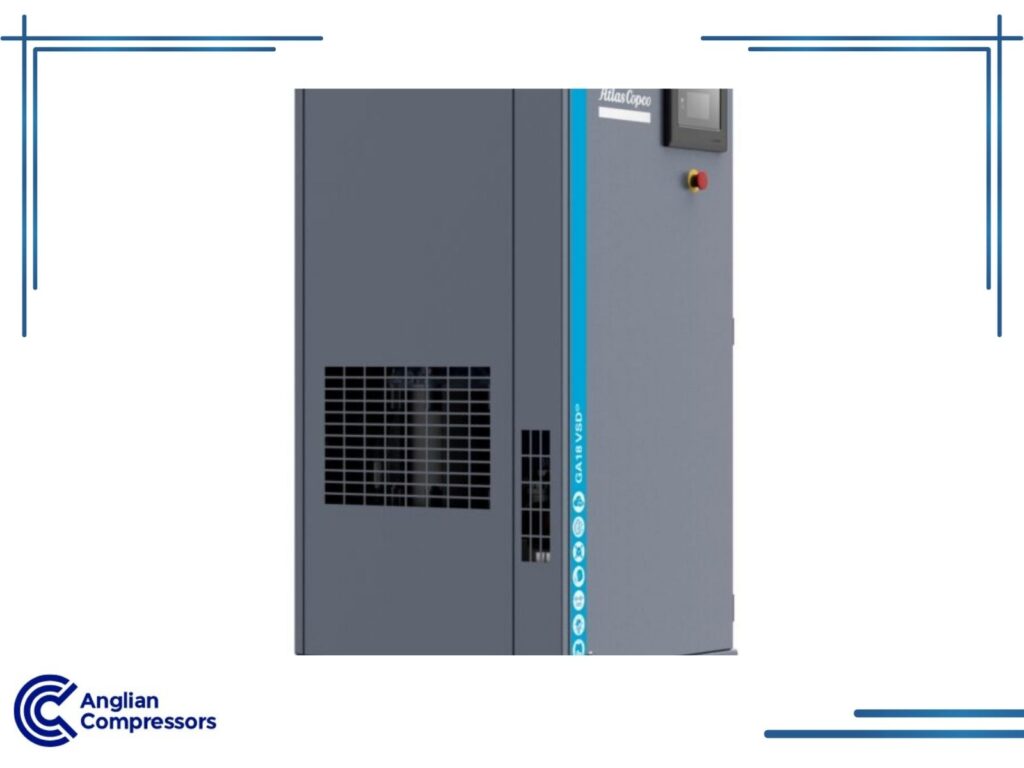Rotary vane vs. rotary screw compressors: what’s the difference?
There are multiple types of compressors on the market, the rotary screw is definitely the most favoured type, but rotary vane compressors are sometimes also used. These are standouts for several reasons, including running quieter, being lower maintenance compared to other compressor types, and with a potentially smaller footprint.
Rotary vane and rotary screw compressors often get considered together because of their name similarities.rotary vane air compressors are also known as sliding vane compressors.
Nevertheless, as you’ll discover, there are many differences between them.
Which is the right one for your business? The following details each air compressor type, their benefits, and what sets them apart.
Table of Contents
What Is a Rotary Vane Compressor?
Rotary vane compressor technology has existed since at least 1874, when a patent for it’s design was first issued. The basic design relies on positive displacement and centrifugal forces for air compression.
The design of this compressor type uses a cylindrical housing and rotary vanes, which are adjustable, on a drive shaft that sits off-centre. There is also both an air inlet and an outlet too. Airtight chambers are created inside the cylinder wall, and as the vanes rotate, a gradually reducing air volume compresses the air.
The internal mechanism is sometimes oil-lubricated to help maintain airtight seals, but not always. Once compressed sufficiently, the air is transferred to an oil separator. Any remaining lubricant is removed through a further process. Then an aftercooler is used to extract condensation to reduce moisture, or any water present.
Despite the earliest design being over a century old, modernised vane compressors exist because of their design simplicity, effectiveness, and efficiency.
What Is a Rotary Screw Compressor?
The rotary screw compressor is a newer technology than rotary vane compressors. It uses two screw rotors, with a pair of drive shafts side by side. There is also the obligatory air inlet and outlet too.
The design relies on the opposing motion of each rotor. There is an intertwining of the rotors as they move as one. The contrary movement has the effect of trapping air between the flutes and the lobes within the rotor’s structure. With the rotors turning together, space becomes more and more restricted, creating compressed air.
Both oil-free and oil-lubricated screw compressors are available:
Oil-free screw compressors: They regulate internal temperature levels using different methods without relying on oil as a lubricant. Designs vary within oil-free models, including ones where the rotors don’t conduct heat and remain cooler, water-cooled rotors, or air-cooled rotor systems. These compressors remove the risk of oil contaminating compressed air, which is requested by the likes of food or pharmaceutical industries.
Oil-lubricated screw compressors: They regulate internal temperatures by sitting the rotors in oil. With the screw compressor lubricated, it runs cooler, creates excellent seals, and reduces potential noise caused by operational friction. These models use a system of filters, dryers, and other methods to remove oil residue and moisture present in the compressed air.
Rotary Vane vs Rotary Screw Compressors: What’s the Difference?
Buyers often choose between a rotary vane air compressor and a rotary screw compressor, but they do possess some distinct differences.
Here are the major differences and differentiators to be aware of:
Leakage and Lubrication Needs
Rotary vane compressor air seals are good and improve after the initial installation. However, excessive wear results from the continual movement of the vanes into and out of the rotor vane slot. When this occurs, the air seal becomes less than perfect. Bigger vane compressors use a parallel compressor structure, making them more vulnerable to wear and tear on internal parts.
Lubrication is always required to avoid friction damage and to seal gaps that let air escape. Additionally, there is the risk of sludge accumulation and varnishing of the stator bores when insufficient oil is present. High-quality lubricant is needed to prevent sludge development. Also, lubricants must be changed every 2,000 running hours. This is twice as frequent as with rotary screw compressors.
Rotary screw air compressors do occasionally experience air leakages. However, modern rotary screw compressors operate at high speed and consequently reduce air leakage. Updated designs, including oil-injected versions, aid in creating more complete air seals. Additionally, precision helical part manufacturing for oil-free compressors offers another option to remove air leaks through superior technologically superior manufacturing.
As a rotary screw compressor ages, clearance gaps widen with greater air leakage likely. This is mitigated by maintaining the necessary lubrication to seal the widening gaps.
Uses for Industry
Rotary vane compressors have a horizontal design, rather than an upright one, as with rotary screw versions. Therefore, they do occupy a larger footprint after professional installation. Their small total size and reasonably quiet operation, compared to some other types of air compressors, make them a favourite in industries that value these traits, e.g., farming, and automotive.
Some industries avoid vane compressors, though. This is because of the need for oil and requiring a 100% oil-free compressed air producer. Additionally, where nearby, internal air quality is contaminated, such as in a sawmill, contaminants would eventually cause the vane compressor to seize up.
Rotary screw air compressors are designed to stand vertically. As a result, their footprint is as small as 2 meters by 2 meters (slightly larger when a built-in dryer is needed). Despite this smaller footprint, they still possess substantial compressed air production capability.
For oil-sensitive uses, such as in the hospitality or food & beverage industries, oil-free screw compressors are a solid choice. Furthermore, in environments with internally unclean air, rotary air compressor versions avoid the risk of getting clogged up.
Speed Control and Energy Consumption
Rotary vane compressors are restricted to a maximum of approximately 1,100 RPMs due to their use of centrifugal force (a Rotary screw compressor operates up to 3 times faster). Furthermore, it’s vanes are the most susceptible to damage, or excessive early wear and tear, when speed is maxed out.
Modulating control in theory allows for adjustable speeds, with the latest VSD (variable speed drive) vane air compressors offering around 30 percent energy saving at 5 bar pressure levels. However, businesses wishing to start and stop their vane compressor, as needed for batch jobs, may struggle.
It’s worth noting that operating at artificially lowered speeds prevents a proper seal and allows for internal air leakage. Running above 600 RPM is necessary to obtain a balance between good seals and sufficient centrifugal force to reduce unintended wear on internal parts. Unfortunately, operating at lower RPMs only marginally reduces energy consumption.
Rotary screw air compressors enjoy far greater flexibility on load levels, to as low as 15 percent of the maximum, while automatically adjusting energy consumption to reflect this setting. As a result, energy costs are substantially reduced.
The newer VSD rotary screw compressors benefit from up to 60 percent energy savings under various operational conditions. Improved drive trains and magnet motors, along with oil-cooled compressor technology, deliver further energy savings.
Other efficiency-focused techniques, such as heat recovery, open the door to harnessing the heat generated by compressor operations for space heaters or hot water for bathrooms. This potentially reduces the plant’s total energy costs.
Maintenance Needs – Bearings
Rotary vane compressors use bearings to operate efficiently. Fewer bearings are required than with rotary screw compressors. Also, they are the basic shell variety, where damage is quick to spot and fast to replace.
Rotary screw air compressors lack the simplicity of shell bearings. Instead, they rely on several smaller angular bearings. These are subject to fretting, flaking, and other damage, making it necessary to regularly inspect them.
Maintenance Needs – Other Parts
Rotary vane compressor repairs are frequently quicker. One example is replacing vane blades in the compressor. The two-hour task is completed at the site (not returning the machine to the manufacturer). It can be inexpensive compared to repairs on a screw air compressor. Another example is bearing replacements, which occur less often and at a lower replacement cost.
Rotary screw air compressors are more complex by design, with repairs necessarily more complicated. Some repairs cannot be performed at the site. Specifically, the rotors are susceptible to damage. Improper or infrequent lubrication may eventually require a complete replacement of the compressor. When repairs are required, on average, they’re more extensive, time-consuming, and costlier than with a rotary vane.
Expected Lifetime vs. Reality
Rotary vane compressors have an expected lifetime operational use of 90,000 to 110,000 hours, depending on the model. For more businesses, this represents over a decade of use. However, it would be unusual for an operation to maintain older equipment for this length of time. It also assumes that they would ignore – for a decade – all the potential cost savings, and benefits from using a newer, more energy-efficient compressor.
Rotary screw air compressors are expected to run for 80,000 to 120,000 operational hours. However, they provide technological improvements, including the ability to stop or unload quickly to match needs and reduce energy costs. Heat recovery technology can indirectly save money on energy costs by capturing excess heat for use elsewhere in the plant. Therefore, rotary screw compressors are more energy efficient and last sufficiently long before they need replacing.

Confused About Different Compressors? Talk with Anglian Compressors
Each use case is entirely different. If you’re unsure whether a rotary vane, rotary screw, or another type of air compressor is required, get in touch. We will remove any mystery and assist you in choosing the best one for your needs.
Contact us below.


